There is so much more you can do on the 64 squares of the chess board besides playing standard chess. There have been many different variants of chess created over the recent years, some being extremely fun to play, while others offer no real level of excitement.
Nevertheless, in this article, I will reveal the 5 best chess variants that are exciting to play and are most popular among chess players. You will certainly enjoy them as they offer a unique element and are a great alternative to the game of chess.
So if you are bored of playing standard chess, here are 5 variants that will surely spark your interest.
5 Best chess variants:
- Bughouse
- Chess960 (Fischer Random)
- Duckchess
- Crazy house
- No castling
1. Bughouse
Bughouse is one of the most favorite variants among chess players, if not the best. It’s usually played between two teams of 2 players, where both players of the same team work together to deliver checkmate on either boards. The first team to deliver checkmate wins the game.
Unlike standard chess, captured pieces can come back into the game which makes bughouse variant a whole lot exciting. This is done when your teammate captures a piece from his opponent and hands it to you.
You can then drop this captured piece from your pool of pieces anywhere onto the chessboard. For example, to attack your opponent or to defend your king against check.
Bughouse chess variant between top grandmasters
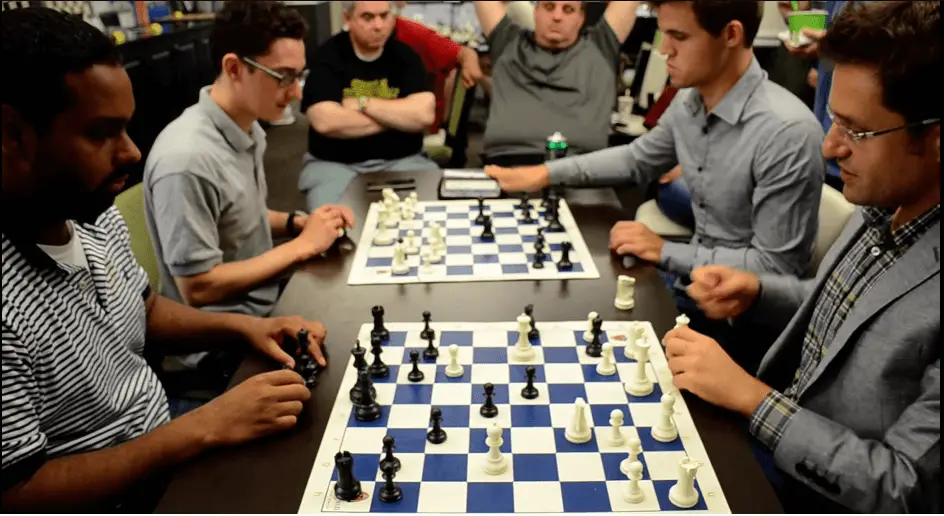
As you can see, bughouse is played on 2 boards and the opposing teams sit across from each other. It’s important that the colors alternate on the two boards.
This means, if you have the white pieces, then your teammate that is sitting beside you should have the black pieces. Conversely, if you’re playing with the black pieces, then your teammate should play with the white pieces.
This ensures that you get the right colored pieces whenever your teammate captures a piece from his opponent and hands it to you. Three minutes is usually added to the clocks. The lower the time, the more fun you will have playing!
What’s The Strategy Involved In Bughouse?
Bughouse is mostly attacking chess, with less than 10% positional play involved. This type of variant will help to develop your visualization and tactical skills over the board.
Bughouse is all about opening lines, sacrificing pieces and dragging out the enemy king in order to deliver checkmate.
Sacrifices that may seem dubious in standard chess is perfectly normal in bughouse as the main strategy is to ruin the king’s shelter even as early on the first few moves.
White sacrifices his knight on move 3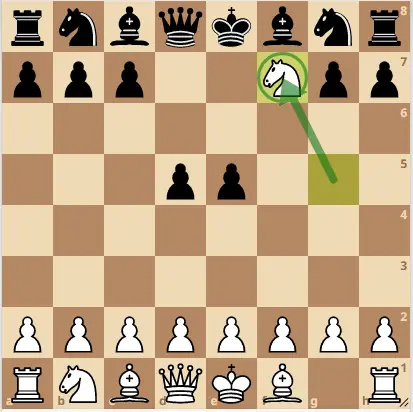
After Kxf7, Black has lost all castling rights and the king is now exposed in the open. White will use whatever pieces he has gained from his teammate to attack the black king.
(Note: You cannot place a pawn on the back rank)
2. Chess 960 (Fischer Random)
Chess 960 also known as Fischer Random is the most popular variant of chess and is played by even the strongest players in the word. It’s called chess 960 because there are 960 legal positions that can occur at the start of the game. It’s also named after former world champion Bobby Fischer who invented and advocated for the game.
This variant is officially recognized under FIDE and even has its own world championship tournament.
The rules are the same as regular chess except that the pieces on the back rank are randomized. The pawns are placed in their regular positions (2nd rank for white and 7th rank for black)
When randomizing the pieces on the back rank, you should bear in mind the following conditions:
- The king must be placed between the two rooks
- The bishops are placed on opposite colored squares
- Mirror the same setup for the opposing side
One of the 960 possible starting positions

How does castling work in Fischer Random?
A player is allowed to castle once under the normal chess rules by moving the king and rook to the same squares they would go to in normal chess.
In order to castle in Fischer random, all the squares between the king and rook must be vacant and cleared from check. Similarly to normal chess, you cannot castle out of check and you cannot castle after moving your king or rook.
When castling kingside, use the rook that is closest to the h-file. For white, move the king to the g1 square and move the rook to the f1 square. Conversely for black, move the king to the g8 square and move the rook to the f8 square as if you were castling in standard chess.
When castling queenside, use the rook that is closest to the a-file. Move that rook to the d1 square for white and move your king to the c1 square. For black, move the rook to the d8 square and move the king to the c8 square.
Random position: Before castling
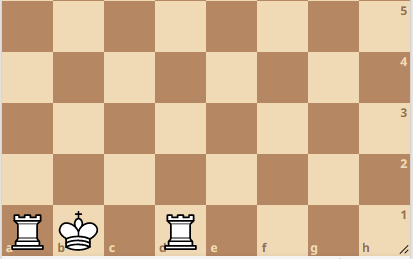
After castling
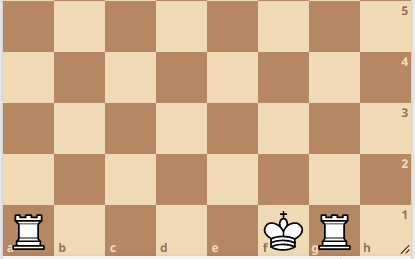
Note: In some positions, your king is already on the castling square. All you need to do is jump your rook over and land it beside the king to complete castling.
Black can castle kingside in one move by jumping his h8 to rook to the f8 square as the king is already on g8.

What’s The Strategy Involved In Fischer Random?
This will depend on the type of setup you get at the start of the game. However, 3 strategies remain the same as in standard chess:
- Gain space (advance your pawns forward)
- Develop your pieces quickly (get your pieces off the back rank)
- Keep your king safe (castle when given the chance)
It’s no different than regular chess, so you shouldn’t sweat it. The only thing that is gone from the game is opening theory. This means that we are starting from scratch and all we have to depend on is basic principles of chess.
3. Duck Chess
The rules of duck chess are the same for regular chess with an added twist. There is no check or checkmate. The obective of the game is to capture your opponent’s king.
This variant is played with a duck that you can place anywhere on the board for strategic, defensive or tactical purposes. The duck is an obstacle that no piece can share a space with. In other words, you cannot capture the duck or move your pieces through the duck. Knights are allowed to jump over it though.
On your turn, after making your move, you must move the duck to any empty square on the board.

Unlike standard chess, you can actually move your king to an endangered square. However, be sure to place the duck along the path so that your opponent can’t capture your king.
Use the duck to block threats

(Note: you don’t have to block the threat with the duck if you don’t want to)
Some important rules you need to know:
- You are allowed to castle through check or out of check, but you cannot castle through the duck.
Before castling

After castling: Not allowed
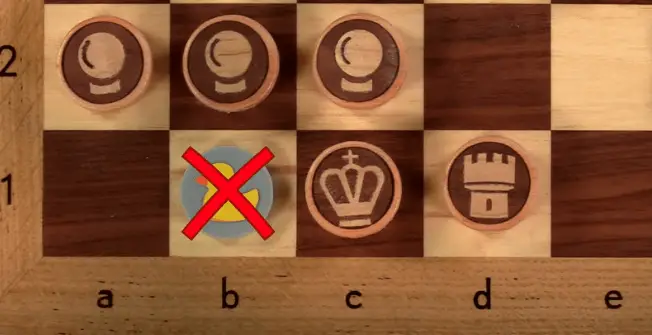
- There is no stalemate. If on your turn, you have no possible moves whatsoever (not even a king move onto a threatened space) then you have been fowled and you win the game immediately!
4. Crazy House
Crazy house follows the general rules of chess. However, when you capture an opponent’s piece, it is placed in your “pool of pieces”.
On your turn, instead of moving a piece, you can drop a piece from your pool on any empty space on the board.
Pieces may not be dropped on occupied squares. You are allowed to drop a piece to give check or checkmate to the opposing king.
Like Bughouse, pawns may not be dropped on the 1st or 8th rank.
Understanding The Pool
Whenever you capture a piece, it goes into your pool and changes over color to match your colored pieces. For example, if you are playing with the white pieces and you capture your opponent’s black knight, that knight goes into your pool and turns into a white knight. You can then place this knight anywhere on an empty square of the chess board.
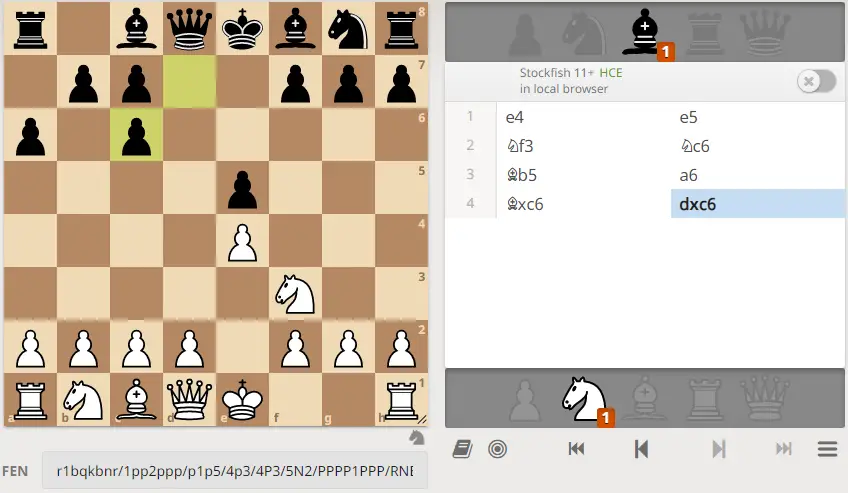
This is a common position reached in the exchange variation of the Ruy Lopez chess opening after 1.e4 e5 2.Nf3 Nc6 4.Bb5 a6 5.Bxc6 dxc6. White bishop captures the black knight on f6. Black recaptures with his d pawn.
On the right, you can see the pool of pieces that have been captured. See how the color changes?
5. No Castling Chess
As the name suggests, you are not allowed to castle in this variant but all the general rules of chess still apply. If you want to castle in no castling chess, you would have to do it artificially.
Artificial castling is a sequence of moves done with the king and rook in order to get your king to a safe square as if it was castled regularly. Castling artificially is not all that easy. You need to bear in mind some factors if you wish to successfully castle artificially. This includes:
- Ensuring that the center is closed so that your opponent can’t open up the position.
- Secure the escape route for your king to castle
- Ensure that your opponent’s bishop cannot attack your king. Sometimes it’s best to trade it off with one of your pieces, or close the position in order to restrict its activity.
You can implement these 3 strategies when playing this variant of chess.
To learn more about artificial castling, read this article: Can you castle after moving your king?
No castling chess has also risen in popularity after the successful 4 game-experiment between world champions Vishwanathan Anand and Vladimir Kramnik which ended in 2.5-1.5 in favor of Anand.
You can view all their 4 games below👇
Other Notable Variants Of Chess
There you have it. The 5 most exciting variants of chess that you can try if you ever get tired of playing standard chess. However, there are several other variants of chess that are worthy of mentioning. These include:
King of the hill: The objective of this variant is to get you king to the center of the board, which is referred to as the ‘top of the hill’. The center is any of the four squares (e4, e5, d4 or d5).
This makes for a very interesting and unique game. The game also ends in the traditional ways of checkmate, flagging your opponent or stalemate.
3 check: The game of 3 check follows the same general rules of chess and ends in the traditional way of checkmate, time-out and stalemate. However, the game also ends if you can deliver 3 checks to your opponent’s king. If this happens you win the game. Conversely, if your king gets checked 3 times, then you lose.
Horde: Set up white as normal. Set up black with 36 pawns (no pieces). White’s objective is to capture all of black’s 36 pawns. Black’s objective is to checkmate white’s king.
Atomic chess: The obective of the game is to checkmate or ‘blow up’ the enemy king’. Whenever a piece is captured, a 3×3 explosion on the captured space occurs. This explosion removes all pieces in its range.
Blindfold chess: It’s the same as regular chess, only difference is that players do not get to see the pieces on the board. Moves are made by orally communicating recognized chess notations. You usually have an assistant (mediator) to make the moves for both players while they turn their backs to the chess board (blindfolded)
Blindfold chess helps to develop your visualization skills and memory in chess which are important skills to have if you want to have an edge over strong opponents.


